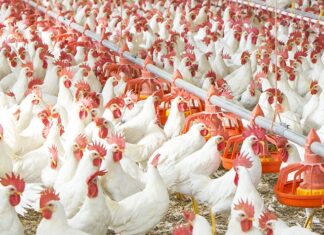WASHINGTON: New orders for key US-made capital goods rose modestly in July while shipments fell by the most in nearly three years, pointing to continued weakness in business investment and a slowdown in economic growth early in the third quarter.
Coming against the backdrop of an escalation in US-China trade tensions, the report from the Commerce Department on Monday could provide more ammunition for the Federal Reserve to cut interest rates again next month.
Fed Chair Jerome Powell told a conference of central bankers last week that trade policy uncertainty seems to be playing “a role in the global slowdown and in weak manufacturing and capital spending in the United States.” Though Powell described the economy as being in a “favourable place,” he reiterated that the US central bank would “act as appropriate” to keep the longest economic expansion in history on the track.
The Fed lowered its short-term interest rate by 25 basis points last month for the first time since 2008, citing trade tensions and slowing global growth. Financial markets have fully priced in another quarter-percentage-point cut at the Fed’s Sept. 17-18 policy meeting.
“The report reaffirms that industrial sector activity and business investment remain soft, in line with weakness globally as trade concerns weigh on activity,” said Veronica Clark, an economist at Citigroup in New York. “With remaining downside risks, we continue to expect that the Fed will again cut rates by 25 basis points at its meeting in September.”
Orders for non-defence capital goods excluding aircraft, a closely watched proxy for business spending plans, increased 0.4pc last month, the government said, driven by strong demand for electrical equipment, appliances and components.
Data for June was revised down to show these so-called core capital goods orders advancing 0.9pc instead of surging 1.5pc as previously reported.
Economists polled by Reuters had forecast core capital goods orders would fall 0.1pc in July. Core capital goods orders increased 1.5pc on a year-on-year basis.
Shipments of core capital goods fell 0.7pc last month, the biggest drop since October 2016. Core capital goods shipments are used to calculate equipment spending in the government’s gross domestic product measurement. Data for June was revised down to show core capital goods shipments were unchanged instead of rising 0.3pc as previously reported.
President Donald Trump on Friday announced a new round of tariffs on Chinese imports, hours after Beijing unveiled retaliatory tariffs on $75 billion worth of US goods. On Monday, the two economic powerhouses sought to ease tensions, with Beijing calling for calm and Trump predicting a deal.
The dollar strengthened against a basket of currencies on the latest news in the trade war, while US Treasury prices were largely trading higher. Stocks on Wall Street rebounded after tumbling on Friday.
SHIPMENTS FALL
The drop in core capital goods shipments suggests business spending on equipment softened at the start of the third quarter, which could weigh on overall business investment and GDP growth. Business investment contracted in the second quarter for the first time since the first quarter of 2016.
Expectations for slower economic growth were also reinforced by a separate report on Monday from the Chicago Fed showing its national activity index fell to a reading of -0.36 in July from 0.03 in June. According to the Chicago Fed, negative readings have been associated with below-average economic growth.
The economy grew at a 2.1pc annualized pace in the second quarter. Weak business investment is underscored by manufacturing, where output has contracted for two straight quarters. Manufacturing, which accounts for about 12pc of the economy, is also being undercut by inventory bloat and design problems at Boeing.
In July, orders for electrical equipment, appliances and components jumped 1.1pc. But orders for machinery fell 0.6pc. There were also declines in orders for primary metals and fabricated metal products.
Overall orders for durable goods, items ranging from toasters to aircraft that are meant to last three years or more, increased 2.1pc in July, the most since August 2018, after rising 1.8pc in the prior month.
Orders for transportation equipment jumped 7.0pc after gaining 4.1pc in June. Motor vehicles and parts orders rose 0.5pc last month. Orders for non-defence aircraft and parts increased 47.8pc. Boeing reported on its website that it had received orders for 31 aircraft in July, excluding its troubled 737 MAX plane, up from only nine in June.
The world’s largest planemaker has cut production of the 737 MAX, which was grounded in March following two fatal crashes in Ethiopia and Indonesia. Deliveries of the plane have also been suspended, leading to a 16.2pc drop in aircraft shipments in July.
Overall durable goods shipments dropped 1.1pc last month. Unfilled orders for these goods edged up 0.1pc, while inventories increased 0.4pc, suggesting manufacturing would probably continue to struggle in the coming months.
“The data confirm that business investment momentum continues to fade and is likely to provide limited support to GDP growth in the second half,” said Lydia Boussour, a senior US economist at Oxford Economics in New York.
“The combination of tighter financial conditions, elevated trade uncertainty and deteriorating global growth will weigh on investment decisions in coming months, putting further downside risk to the already fragile business investment picture.”






















